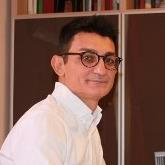New Trends in Bioprinting
A special issue of Materials (ISSN 1996-1944). This special issue belongs to the section "Biomaterials".
Deadline for manuscript submissions: closed (10 September 2022) | Viewed by 5565
Special Issue Editors
Interests: multiscale and multimaterial bioprinting; mathematical modeling of bioprinting processes
Interests: bioengineering; biomedical engineering; tissue engineering; microfabrication; bioreactors for tissue culture; microactuators fabrication
Special Issues, Collections and Topics in MDPI journals
Special Issue Information
Dear Colleagues,
Bioprinting has been defined as the computer-aided process for producing bioengineered constructs, composed of living and nonliving materials, mimicking tissues or organs with high throughput and reproducibility. This process, started as a key enabling approach for tissue engineering and regenerative medicine, has evolved into a mature research field. For example, bioprinted in vitro models are now under evaluation for replacing in vivo models, and bioprinting companies, with sustainable business models, offer both bioinks and bioprinters with affordable prices, promoting applications in translational medicine.
Taking advantage of the interaction with other research fields such as robotics, additive manufacturing, green chemistry, multiple innovations are continuously deployed, with impacts in biology and biotechnology, for producing, e.g., biosensors, biological machines, supports for catalysis, and tools for life-in-space exploration.
The Guest Editor of this Special Issue will consider articles that present the recent advances in the research and applications of bioprinting, with a particular interest in:
- Innovative bioprinting technologies, including 4D bioprinting;
- In situ bioprinting;
- Mathematical modeling of bioprinting processes;
- Bioprinting of sustainable biomaterial inks and bioinks;
- Molecular analysis of bioprinted constructs;
- Bioprinting applications for space exploration;
- Bioprinting applications in biotechnology.
Dr. Carmelo De Maria
Prof. Dr. Giovanni Vozzi
Prof. Dr. Thomas Boland
Guest Editors
Manuscript Submission Information
Manuscripts should be submitted online at www.mdpi.com by registering and logging in to this website. Once you are registered, click here to go to the submission form. Manuscripts can be submitted until the deadline. All submissions that pass pre-check are peer-reviewed. Accepted papers will be published continuously in the journal (as soon as accepted) and will be listed together on the special issue website. Research articles, review articles as well as short communications are invited. For planned papers, a title and short abstract (about 100 words) can be sent to the Editorial Office for announcement on this website.
Submitted manuscripts should not have been published previously, nor be under consideration for publication elsewhere (except conference proceedings papers). All manuscripts are thoroughly refereed through a single-blind peer-review process. A guide for authors and other relevant information for submission of manuscripts is available on the Instructions for Authors page. Materials is an international peer-reviewed open access semimonthly journal published by MDPI.
Please visit the Instructions for Authors page before submitting a manuscript. The Article Processing Charge (APC) for publication in this open access journal is 2600 CHF (Swiss Francs). Submitted papers should be well formatted and use good English. Authors may use MDPI's English editing service prior to publication or during author revisions.
Keywords
- bioprinting
- biofabrication, in vitro model
- scaffold
- bioink
- tissue engineering
- regenerative medicine
- biotechnology
Benefits of Publishing in a Special Issue
- Ease of navigation: Grouping papers by topic helps scholars navigate broad scope journals more efficiently.
- Greater discoverability: Special Issues support the reach and impact of scientific research. Articles in Special Issues are more discoverable and cited more frequently.
- Expansion of research network: Special Issues facilitate connections among authors, fostering scientific collaborations.
- External promotion: Articles in Special Issues are often promoted through the journal's social media, increasing their visibility.
- e-Book format: Special Issues with more than 10 articles can be published as dedicated e-books, ensuring wide and rapid dissemination.
Further information on MDPI's Special Issue polices can be found here.








